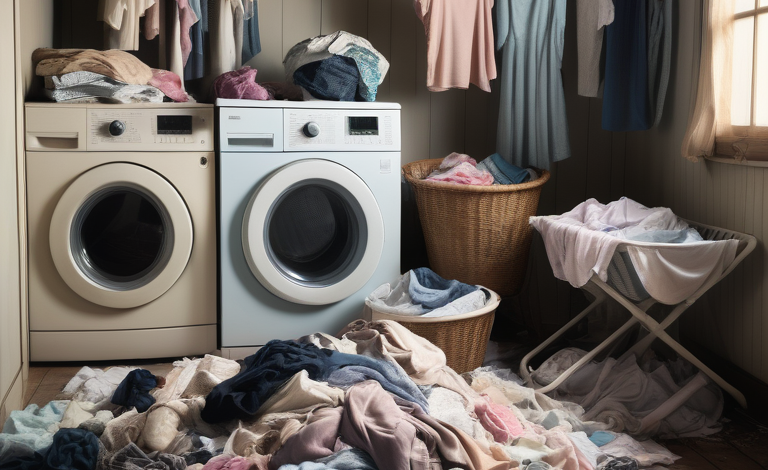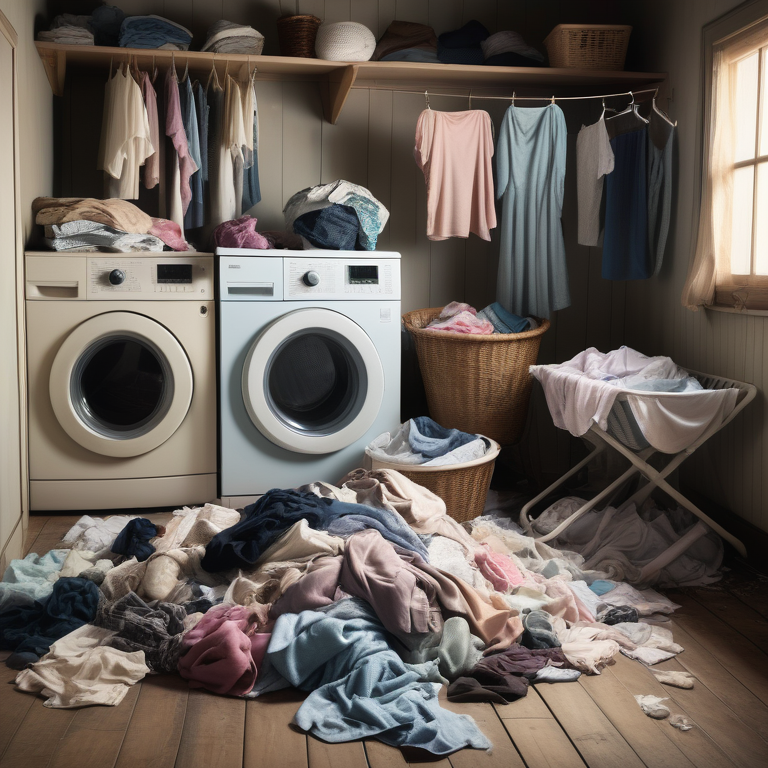What Happens When Clothes are Soaked Too Long


Key Highlights
- Soaking clothes for an extended period can be detrimental to their quality.
- While intended to lift dirt and grime, prolonged soaking can lead to issues like color fading and fabric damage.
- For instance, delicate fabrics such as silk or wool are particularly prone to damage with excessive soaking.
- Moreover, leaving clothes, especially dirty ones, damp for too long creates a conducive environment for bacterial growth, resulting in unpleasant odors.
- Therefore, it’s best to stick to the recommended soaking times on garment care labels and avoid soaking for longer than necessary.
Introduction
Many believe that soaking dirty clothes in a washing machine for a long time is the key to spotless laundry. However, it’s not always the case. This article will clear up common misunderstandings about soaking clothes and explain why leaving them soaking for extended periods might do more harm than good.
The Science Behind Soaking Clothes
Soaking, essentially, gives water and detergent more time to penetrate fabric fibers, loosening dirt and stains. This process is particularly helpful for heavily soiled clothes. However, the duration of soaking is crucial.
A balanced approach is key; while a short soak can be beneficial, excessive soaking can be counterproductive, leading to unwanted consequences for your garments.
How Water Affects Fabric Fibers
When fabric comes into contact with water, the fibers absorb it, causing them to swell. Cold water typically causes minimal swelling, while warm or hot water can lead to more significant expansion. This swelling action is generally not a concern during regular washing, as the agitation helps release dirt and grime.
However, prolonged soaking, especially in warm water, can over-saturate the fibers. This can disrupt the fabric’s structure, making it more susceptible to damage, particularly for delicate fabrics.
Therefore, being mindful of both water temperature and soaking duration is vital to prevent unintended fabric damage.
The Role of Detergents in Soaking
Detergents play a crucial role in the soaking process as they contain surfactants. Surfactants work by lifting dirt and grime from fabric fibers and suspending them in the water, making it easier to rinse them away.
During soaking, detergents have an extended opportunity to loosen and break down stubborn stains, enhancing their cleaning effectiveness. However, leaving clothes submerged in detergent for prolonged periods, especially harsh detergents, can harm the fabric.
Detergent residues can build up on the fibers, leading to stiffness, discoloration, or even weakening of the fabric over time. Therefore, using the appropriate type and amount of detergent and adhering to recommended soaking times is advisable.
Common Misconceptions About Soaking Clothes
One common misconception is that the longer you soak your clothes, the cleaner they will get. However, as we’ve learned, this isn’t always true. Over-soaking can lead to a range of problems, from color fading to fabric damage.
Another misconception is that all fabrics can withstand prolonged soaking. This is false, as delicate materials, such as silk, lace, or wool, are much more susceptible to damage and require special care, including minimal soaking time.
Myth vs. Reality: Soaking Duration
The ideal soaking time varies depending on the fabric and the severity of the stains. For lightly soiled items, a short soak of 30 minutes to an hour in cold water is sufficient. For more stubborn stains, a pre-treatment with stain remover or a slightly longer soak, up to a few hours in cold or lukewarm water, might be necessary.
However, soaking clothes overnight or for an extended period is generally not recommended. While it might seem tempting, especially for heavily soiled laundry, such prolonged exposure to water and detergent can be counterproductive.
Instead of achieving a deeper clean, excessive soaking can weaken the fabric, dull colors, and potentially harbor bacterial growth, leading to unpleasant odors. Always check the care label on your garments for specific soaking guidelines and follow those instructions for best results.
Can Soaking Damage Clothes?
Yes, soaking clothes, especially improperly, can lead to damage. Extended soaking can weaken fabric fibers, particularly in delicate materials like silk or wool. It’s crucial to follow recommended soaking times and avoid any harsh chemicals or treatments not explicitly mentioned on the care labels.
Furthermore, even sturdy fabrics like cotton can experience damage with prolonged exposure to water and detergent. The continuous saturation can break down the fibers, leading to tears, holes, or overall weakening of the material.
Therefore, exercise caution while soaking clothes. Consider it a pretreatment for stubborn stains rather than a regular laundry step. Remember, gentle care and following care instructions are key to preserving the quality and lifespan of your garments.
Potential Consequences of Over-Soaking
Over-soaking can jeopardize the appearance and structural integrity of your clothes. One major consequence is the potential for color damage, which can leave your vibrant garments looking dull and faded.
Another significant issue is the possibility of weakening the fabric, making it more susceptible to tearing, stretching, or losing its original shape. Recognizing these risks allows you to adopt proper laundry practices to maintain the quality of your clothes.
Color Fading and Bleeding
One of the most noticeable consequences of over-soaking is color fading. Many garments are dyed using pigments that can be loosened and released into the water with prolonged soaking, especially in warm or hot water. This results in a noticeable dulling or fading of the original color.
Moreover, certain fabrics, especially brightly colored ones, are prone to color bleeding. When left soaking for too long, the dyes can bleed onto other garments, ruining their appearance. This is particularly common with new clothes that haven’t been washed multiple times.
To minimize the risk of color fading and bleeding, always sort your laundry carefully. Wash like colors together, and for new or brightly colored items, consider washing them separately, especially for the first few washes.
Fabric Weakening and Damage
As mentioned earlier, over-soaking can weaken fabric fibers. When fabrics remain submerged for extended periods, water molecules penetrate the fibers, causing them to swell. While this swelling is usually temporary and reverses during drying, prolonged soaking can lead to permanent damage.
Delicate fabrics, such as silk, lace, or wool are particularly susceptible to this type of damage. Their fibers are delicate and easily disrupted by excessive water absorption. This can cause the fabric to become misshapen, stretched, or even tear.
To protect your delicate garments, always hand wash or use the gentle cycle on your washing machine. Minimize soaking times and avoid any harsh scrubbing. These precautions will help preserve the delicate structure of these fabrics.
Conclusion
In conclusion, understanding the impacts of soaking clothes for extended periods is crucial. Excessive soaking can lead to color fading, bleeding, fabric weakening, and damage. It’s essential to be mindful of soaking duration to prevent potential consequences on your clothes. Addressing common misconceptions and following proper laundry practices can help maintain the longevity and quality of your clothing. If you have further questions about soaking clothes or laundry care, refer to our frequently asked questions section for additional guidance. Prioritize proper garment care to ensure your clothes stay fresh and in good condition for longer use.
Frequently Asked Questions
Is it safe to soak clothes overnight?
Soaking clothes overnight is generally not recommended. It can lead to bacterial growth, causing unpleasant odors, and might damage the fabric. Always refer to the care instructions on your clothes.
How long is too long for soaking clothes?
Soaking for an extended period, typically exceeding eight hours, is often deemed excessive and can negatively impact the fabric, color, and integrity of your clothes. Following the garment’s care instructions is always recommended for optimal results.
Is soaking your clothes overnight bad?
Leaving clothes soaking overnight, especially if they’re damp, can promote bacterial growth and lead to musty odors. Additionally, prolonged exposure to water can weaken the fabric, potentially leading to damage.
How Long Can You Leave Laundry in the Washer?
It’s best to transfer laundry to the dryer promptly after washing. Leaving wet laundry in the washer for more than a couple of hours can create a conducive environment for bacterial growth, leading to musty odors.
Does soaking clothes excessively lead to shrinking or stretching?
Yes, excessive soaking can cause certain fabrics like wool to shrink or lose their shape. Always check your garment’s care instructions for specific guidelines on soaking.
Can anything bad happen from soaking my clothes too long?
Absolutely. Over-soaking can lead to damage, including color fading, unpleasant odors due to bacterial growth, and fabric weakening. It’s best to stick to the recommended soaking times on your garment’s care labels.









